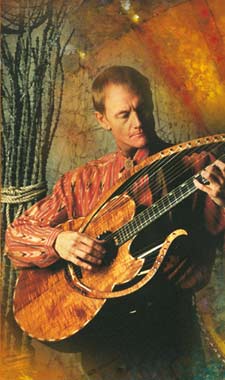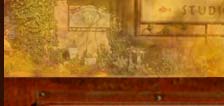


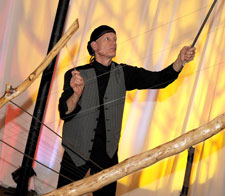
William Eaton & Tree Harp

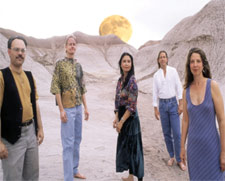
William Eaton Ensemble
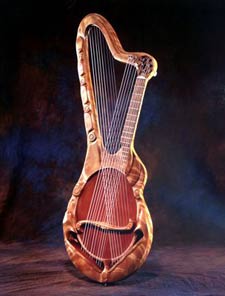


William Eaton has performed and recorded as a soloist, with Native American Flutist R. Carlos Nakai, percussionist Will Clipman, Tibetan flutist Nawang Khechog with the Nouveau West Chamber Orchestra, the Nebraska Chamber Orchestra, and with ensembles he has formed, including musicians: Clipman, Claudia Tulip, Allen Ames, Mary Redhouse, Edgar Meyer, Udi Arouh, Arvel Bird, Robert Tree Cody, Rachel Harris, Keith Johnson, Vusi Shibambo, Fitzhugh Jenkins, Zirque Bonner, and the Monks of the Tibetan Drepung Loseling Monastery. As a soloist and with the above artists Eaton has completed ten recordings for the Canyon Records label.

An innovative artist, Eaton’s musical composition is an evocative style that captures the spirit of the Southwest. Combining structure with improvisation he has written scores for chamber orchestra and Sonoran desert ensembles, ambient landscape music, lyric folk songs, indigenous trance music, and sound track scores including the Emmy award winning video “Beyond Tradition.” He has composed and co-composed ten albums for Canyon Records including the Grammy nominated Ancestral Voices and In A Distant Place.
“With an ensemble of violin, pan-global percussion, and winds, Eaton makes a world chamber sound that’s evocative and melodic, merging intuitive interplay and a rare timbral richness.”
- Billboard Magazine
Music of the William Eaton Ensemble resounds within the landscape, light and life of the northern Sonoran Desert. Tradition meets new exploration. The Ensemble’s music is a melding of sounds from diverse origins. Notes from William Eaton’s unique stringed instruments (harp guitar, spiral clef, o’ele’n strings, lyraharp guitar) combine with Claudia Tulip’s silver and indigenous flutes and pan pipes, Allen Ame’s invented six string violyra and violin, Mary Redhouse’s five octave native voice, and ethnic-world percussion from players Will Clipman and Keith Johnson. The resulting music is a collection of grace-touched melodies in rich impressionistic arrangements that transports the listener to the far reaches of the imagination.
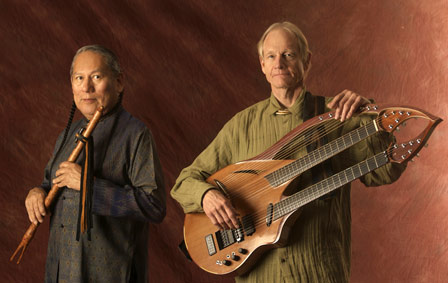
Eaton has collaborated with R. Carlos Nakai, the world’s premier performer of the Native American flute, since 1986. Their first three recordings on Canyon Records received critical acclaim, including the GRAMMY® nominated Ancestral Voices for Best Traditional Folk Album in 1994. In 1995 multi-talented world percussionist Will Clipman joined with the duo to add rhythmic nuance and trance-groove to the mix. The trio released Feather, Stone and Light, a Critic’s Choice by Billboard magazine in 1995 and Red Wind in 1998 a NAMMY winner for Best Instrumental Album of the Year (Native American Music Awards). Tibetan flutist Nawang Khechog joined the trio in 2001 for the recording In A Distant Place a GRAMMY® finalist for best New Age album of the year.
Acknowledged as one of the world’s great designers and builders of unique guitars, Eaton’s instruments have been featured in books, magazines, video, luthier conventions and at international exhibits. As an apprentice to John Roberts he built his first guitar in 1971. Along with Roberts and Bob Venn, he co-founded the Roberto-Venn School of Luthiery in Phoenix in 1975, where he continues as director of the school and creator of new instruments.
Biography
Out in western Nebraska, there's a couple of windswept little towns on the Platte River where some people try to eke out a living from the dry soil. Even along the river, miles separate individual households, and north, in the sandhills, the solitude is as profound as any on the continent. Antelope still roam out there. Flocks of migrating Canadian geese rest in the river shallows in November, crossing this ribbon of water on the fly ways towards the Gulf of Mexico.
William Eaton's parents met and fell in love in this country and the taste and touch of this fading world lives on in their children. It's a pure Americanism, direct and honest, spacious and easy going, informed by daily contact with the wide open infinities of time and space and the windy relentless prairie.
While Eaton grew up in Lincoln, Nebraska, he has always returned for holidays and family gatherings to the original home in Lisco, on the river, where his grandmother still lives. When he was seven his Uncle Charlie gave him a ukulele and showed him the chords for "Has Anybody Seen My Gal?".
His first performance was before an audience of 800 at Irving Junior High School in Lincoln, playing banjo and guitar with The Balladeers, a folk trio including his older brother. In high school, as lead guitarist for Candy Machine, Eaton spent most Saturday nights in farm towns hundreds of miles from home playing the top 40 music of the 1960's to local teens starved for links with the outside world.
When he moved to Arizona to attend Arizona State University in Tempe, the demands of his schedule did not permit participation in a musical group. For a time he considered musical performance a pursuit he'd have to give up as he accepted the responsibilities of adulthood. His considerable intensity was devoted to academics and athletics, areas in which he excelled. His guitar was tucked under his bed, only to come out when he needed a break from the efforts which earned him the ASU pole vaulting record and the title "Outstanding Graduate" of the Business College. But another factor was beginning to influence Eaton at this time - the surrounding country was working a spell on him.
The voice of the desert, that dry and brittle presence behind all the activity around college life captivated this young Nebraskan. Here was another solitude, another silence, another infinity beyond society; a place of origin. Opening to desert life permitted Eaton to see Tempe's local characters in a different light.
A chance meeting with a luthier student led Eaton to visit the Juan Roberto Guitar Works, a sweltering Quonset hut established when ex-pilot and luthier John Roberts returned from years in Nicaragua,
flying for a lumber company, bringing with him a lifetime supply of exotic tropical hardwoods. Here in 1971, Eaton built his first guitar and his 26 year association with Roberts began.
He felt his business education was incomplete, so Eaton attended the two-year MBA program at Stanford where he specialized in small business finance and accounting. While at Stanford, Eaton also studied classical guitar with teacher Charles Ferguson.
The first years after formal education were critical in developing Eaton's artistic perspectives. Family and academic commitments fulfilled for the moment, he could at last embark on the personal quest which had been taking shape during his school years. While engaged in the Roberto-Venn work, he read omnivorously and investigated the spiritual and philosophical disciplines of many cultures. He spent days and nights outdoors, deep in the mountain areas outside Phoenix. He slept under the stars, living out of his car for two years. He contemplated the origins and dynamics of music. He wandered in the desert, and explored the ideas of "erasing personal history" and "stopping the world". He began to imagine and create the remarkably innovative instruments for which he is noted.
While this was not a time for performance before large human audiences, he began playing pieces in a variety of solitary settings, on a cliff in the moonlight by a quiet pool in a shadowed canyon. This period of Eaton's life is a source for much of his subsequent work, and the subtle qualities of sound, light and air experienced in the desert can be felt behind his every note.
Eaton's return to the audience began after this retreat time. In late 1978, he frequently played in the moonlight near Arcosanti, Paolo Soleri’s experimental community in Central Arizona. Interested people collected to listen to these sessions. Eaton's awareness of the acoustic properties of various spaces, which grew out of his instrument building, led him to stage impromptu concerts in a variety of improbable locations. Handwritten signs promoted events at the Arizona Sand and Gravel Building, the Central Arizona Project Siphon Tunnel at Granite Reef Dam, and the Monroe Street Civic Building, culminating in 1980 with the Sunset Moonrise Concert on South Mountain, the beginning of his formal performance career.
For the following 22 years, Eaton has explored the ways people can be brought to interact with music. Venues for his performances have ranged from intimate music settings to concert halls with a full chamber orchestra behind him, to outdoor amphitheaters with audiences of thousands. He has composed, improvised, collaborated, lyricized and scat sung. Solo performances have alternated with group appearances.
Throughout these years Eaton has always had one instrument or another under construction at the Roberto-Venn School where he continues to teach and serve as the School’s Director. Most recent in his collection, the lyraharp guitar, was designed to incorporate his accumulated knowledge of building guitars, harp guitars and lyres with the sophistication of Roland's synthesizer technology, permitting voicings for nearly every existing musical instrument. The new instrument has had a profound and expansive influence on Eaton's musical directions. A new double neck instrument nearing completion incorporates the use of an on board computer designed by Transperformance that allows instant tuning changes.
Eaton's recording career began in earnest when Carry the Gift, a collaboration with Native American flutist R. Carlos Nakai, was issued by Canyon Records in 1988. The Nakai/Eaton duo, a relationship which began in 1984, has proven to be an appealing combination. The two have played in concerts throughout the U.S. and have recorded six albums together including the duo offerings: Winter Dreams in 1990 and Ancestral Voices, a 1994 Grammy Awards Finalist for "Best Traditional Folk Album".
Eaton has collaborated with other artists as well. On Tracks We Leave (1989), Eaton was joined by Udi Arouh, Arvel Bird, Claudia Tulip, Rich Rodgers and R. Carlos Nakai. Wisdom Tree (1992) features double bassist Edgar Meyer, and includes William Clipman, Robert Tree Cody, Arouh, Bird and Tulip.
On the 1994 Canyon release Where Rivers Meet, Eaton joins with Tulip, Ames, Clipman, and Keith Johnson to form the William Eaton Ensemble.. This recording garnered a "critics choice" designation by Billboard Magazine, referring to the ensemble’s music as "a world chamber sound that’s evocative and melodic."
Feather, Stone & Light, a musical trialogue among Eaton, Nakai, and Clipman released in March of 1995, was also noted as a Billboard Critic's Choice and quickly debuted and remained on Billboard's Top New Age Albums chart for 13 weeks.
The William Eaton Ensemble’s 1997 recording, Naked In Eureka, a musical "glimpse into the folly, mystery and illusion of reality" includes "The Fire Within," a collaboration with the Drepung Monks of the Drepung Loseling Monastery from Tibet and Canyon recording artist, Robert Tree Cody.
The Nakai, Eaton, Clipman Trio’s second recording, Red Wind, received a NAMMY Award (Native American Music Award) in 2000 for Best Instrumental Album of the year. On their most recent recording, "In A Distant Place," Eaton, Nakai and Clipman were joined by Tibetan flutist Nawang Khechog. The CD received a 2001 Grammy nomination for Best New Age recording.
Eaton lives in Arizona with his wife, Christine, and has two children, daughter, Taylor, and son, Walker. Eaton's interests in the varieties of musical experience and expression are sure to lead him into new areas of creation, performance and collaboration. His earliest experiences, childhood time in the sandhills, the years in the desert, the many books and conversations, fuels his curiosity and influence the sounds which come from the remarkable instruments he designs and plays.
Home Events Tickets Theater Studio B Classes Donate Volunteer
Testimonials Map Links Archives Contact
Copyright © 2009-2024 Old Town Center for the Arts. All Rights Reserved.
